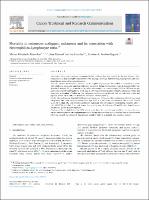Mortality in cutaneous malignant melanoma and its association with Neutrophil-to-Lymphocyte ratio
Related Resource(s)
https://www.sciencedirect.com/science/article/pii/S246829422100160XDate
2021-01Author(s)
Pinto Paz, Mirian Elizabeth
Cotrina Concha, Jose Manuel
Benites Zapata, Vicente A.
Metadata
Show full item recordAlternate title
Mortalidad en melanoma maligno cutáneo y su asociación con la relación neutrófilos a linfocitos
Abstract
Introduction: Cutaneous malignant melanoma (CMM) incidence has risen rapidly in the last 50 years. Poor progression and high mortality characterize CMM, making a thorough understanding of progression and associated factors essential for optimizing care.
Aims: We assessed the association between the Neutrophil-to-Lymphocyte Ratio (NLR) and mortality in adults with CMM from an entirely mixed-race Hispanic population during 12 consecutive years of extensive follow-up.
Material & Methods: We performed a retrospective cohort study in a tertiary hospital in Peru. NLR was categorized with a cutoff value higher or equal than 3. We collected demographic variables, laboratory results and treatments at baseline of follow-up. Cox regression analysis was performed, and we calculated crude and adjusted hazard ratios (HR) and their 95% confidence interval (95%CI).
Results: The analysis was from 615 CMM cases, and there were 378 deaths. Most melanomas (63.6%) were acral lentiginous. The crude analysis showed that high NLR is a risk factor for mortality, HR = 2.52; 95%CI (2.03–3.14). High NRL ratio remains statistically significant after adjusting for confounding variables, aHR = 1.61; 95%CI (1.16–2.24). Other risk factors for mortality were clinical stages III and IV, older than 60 years, females and greater Breslow thickness.
Conclusions: We concluded that high NRL ratio is a risk factor for mortality and should be monitored in every patient who is diagnosed with malignant melanoma during their first blood count. It should then be carried out in follow-up controls for patients of clinical stage III and IV only, or in patients who present a relapse.
Collections
- Artículos científicos [890]






